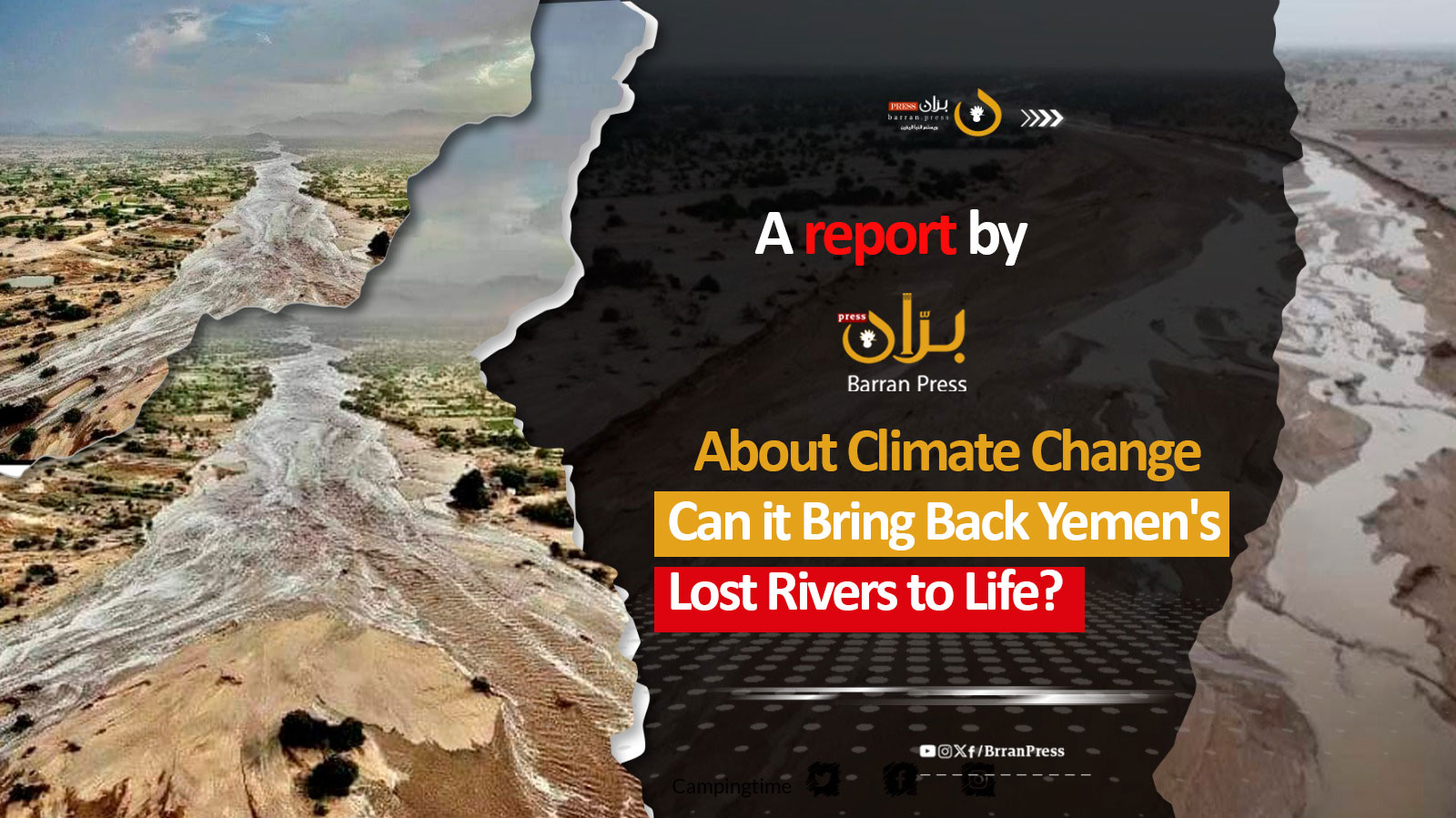
Barran Press | Report prepared by - Ali Al-Aqili
This year's monsoon season brought unprecedented rainfall to Yemen, causing massive floods that overflowed valleys (wadis) and reached the Arabian Sea to the east and the Red Sea to the west. The deluge has reignited debate about the possibility of Yemen's lost rivers returning, particularly the "Khared" river, which historical records suggest existed some 300 years ago, flowing from Sana'a through Al Jawf, and eventually reaching Hadhramaut and the Arabian Sea.
In late August, floodwaters from Sana'a and Amran reached the Al Jawf desert in the northeast, while the waters of Bayhan valley, originating from Al Bayda governorate in the center, reached the Shabwa desert in the southeast.
The Marib dam received numerous floods flowing through the "Thana" valley from Dhamar, Sana'a, Al Bayda, and the mountainous regions south and west of Marib.
These floods carried significant amounts of water into the Red Sea and the Arabian Sea through the valleys of Mor, Seham, and Bana. Experts predict that the flow of these valleys will continue for more than three months, until the end of the year, even if rainfall is scarce during the winter season.
A Convergence of Valleys
According to geologists and researchers, the floods originating from Sana'a, Amran, Dhamar, and Al Bayda provinces flow through Al Jawf, Marib, and Shabwa, converging in the "Thaniyah" desert region east of Marib governorate (northeastern Yemen).
Sheikh Ahmed bin Ali Al Shlaif Al Jahmi, president of the Association of Construction Rocks, recounts accompanying a French expedition to Thaniyah in 2007 and 2008 to investigate the existence of a river that once traversed Yemen from west to east.
Al Jahmi explained that the then-head of the Geological Survey and Mineral Resources Authority, Dr. Ismail Al Jand, requested him to accompany the expedition, which included three French experts and a Yemeni geologist, from Sana'a to Marib. They traveled together to explore the "Thaniyah" desert to ascertain the existence of the river.
"We arrived there, and went beyond Thaniyah by about 12 kilometers, reaching a place that resembled a confluence of floodwaters. The team asked me to dig in that spot to a depth of 7-10 meters. After digging, the team confirmed that this place was the convergence of the valleys: Thana Valley (Marib), Al Jawf, Hareeb south of Marib, and Bayhan northwest of Shabwa," Al Jahmi said.
He added, "The land is desert, covered with sand dunes, with no signs of valley indicating the possibility of Bayhan valley's floodwaters reaching the area. There are also no signs indicating the possibility of the waters of the valleys of Hareeb, Marib, and Al Jawf reaching the area."
In his interview with "Barran Press," Al Jahmi continued, "We dug to a depth of 7 meters, and the soil was the same color throughout, fertile, suitable for agriculture, and not sandy as its surface covered with sand dunes might suggest."
According to Al Shlaif, the experts explained that the presence of fertile soil in that region indicated the presence of flowing water for extended periods, coming from distant locations. They noted that the formation of sand dunes in the area pointed to the cessation of water flow to that region about 300 to 400 years ago, confirming that the waters of the valleys of Marib, Al Jawf, and Bayhan once converged in the Thaniyah region and flowed through Hadhramaut.
Concluding his interview with "Barran Press," Sheikh Al Jahmi said that the research team assured him that they would submit a detailed report on the visit to the Geological Survey Authority, and that "the samples taken from the soil will be examined in laboratories in France to determine the history and duration of water flow in the area."
Climate Change and Hope for Revival
The recent floods, while devastating in some areas, have sparked hope for the revival of Yemen's lost rivers. However, experts caution that climate change is a significant factor in the long-term future of water resources in Yemen.
The country faces increasing droughts, desertification, and water scarcity. The floods, while a temporary reprieve, highlight the need for sustainable water management practices and investment in infrastructure to mitigate the impacts of climate change.
The return of Yemen's lost rivers remains a possibility, but it will require a concerted effort to address the root causes of environmental degradation and ensure the long-term sustainability of water resources.
The Khared River and the possibility of its return
Satellite imagery clearly reveals the ancient riverbed's contours in Yemen's topography. The distinct channels of valleys sloping eastward from the mountainous region stretching from Saada and Amran to Sana'a, Dhamar, and Al Bayda, converge towards a single direction east of Marib and west of Hadhramaut, after traversing Al Jawf, Marib, and Shabwa.
Further analysis of Yemen's topography shows that valleys merging in eastern Hadhramaut meet other valleys originating from the west and south of the province. They continue their course through the "Al Khush'a" region, westward towards Qatn, Shibam, and Seiyun, connecting with wadis from the northern and central Hadhramaut highlands. This path eventually leads to the Arabian Sea through Al Misaila Valley, indicating a historical gradient aligning with the river described in historical accounts.
However, despite the recent floods, experts and researchers believe several factors hinder the return of rivers to Yemen, including the "Khared" River. These factors include:
- Desertification: The widespread desertification in Yemen has significantly impacted the water cycle, reducing the capacity of the land to retain moisture and sustain river flow.
- Dams and Terraces: Numerous dams, earthen barriers, and agricultural terraces built across Yemen's mountains, valleys, and valleys trap water, hindering continuous flow or significantly reducing its volume.
- Depletion of Groundwater: Uncontrolled drilling of wells and the extensive use of flood irrigation in agriculture have depleted groundwater reserves, further contributing to the decline of river systems.
Additionally, Yemen's seasonal rainfall pattern makes it challenging to sustain a continuous water flow in valleys. The country experiences six months of drought each year, and a consistent river flow requires year-round precipitation.
Climate Change: The Underlying Cause
The recent heavy rainfall and subsequent floods in Yemen have raised concerns about the frequency and intensity of such events in the future. Climate experts attribute this shift in weather patterns to global climate change, which is impacting weather patterns across the region.
Khalid Nasser Al-Babakri, a weather and climate expert, explains that the noticeable increase in rainfall in Yemen, including this year, is primarily due to global climate change. He highlights the role of moist eastern waves originating from the Indian Ocean, which have significantly increased rainfall during July and August. These waves carry substantial amounts of water vapor to Yemen, increasing the likelihood of cloud formation and heavy rainfall.
Al-Babakri further emphasizes the heightened activity of these waves and their amplified impact on Yemen's monsoon season, combined with the humid influx from the Horn of Africa, contributing to the increased intensity of the seasonal rainfall.
Future Projections: Extreme Weather Events
Al-Babakri underscores that recent scientific studies suggest the world is entering a new phase of climate change, characterized by an increased probability of extreme weather events, such as heavy rainfall and floods. He warns that Yemen, like many other nations, may experience a recurrence of such events in the coming years.
The primary driver behind these unprecedented extreme weather events, according to Al-Babakri, is the rising temperature of the oceans. Global warming leads to increased evaporation from the oceans, enhancing atmospheric moisture levels and increasing the likelihood of torrential rainfall.
Al-Babakri highlights the significant impact of climate change on Yemen, predicting a shift in climate patterns. He anticipates that some regions will experience more frequent floods due to increased rainfall, while others will suffer from prolonged droughts. These changes will have profound implications for agriculture, water resources, infrastructure, and the livelihoods of Yemen's population.
Rumors and Misinformation
Since the beginning of August 2020, rumors have circulated locally about a statement from the UK Meteorological Office claiming that Yemen has entered the rainfall zone of Ethiopia and Uganda, predicting continued rainfall until mid-2024 and the return of dried-up rivers and springs.
However, Al-Babakri refutes these claims, emphasizing that they are baseless. He asserts that there is no scientific terminology in meteorology that refers to a country entering the rainfall zone of another. He further dismisses the possibility of the UK Meteorological Office issuing such inaccurate and illogical information, explaining that the equator does not shift and is fixed in geography, making it scientifically impossible for Yemen to enter the equatorial zone.





